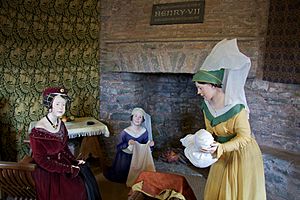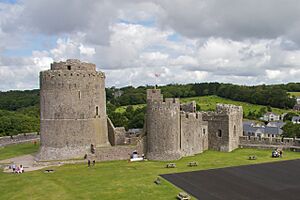Pembroke Castle facts for kids
Quick facts for kids Pembroke Castle |
|
|---|---|
| Pembroke, Pembrokeshire, Wales UK grid reference |
|
 |
|
| Type | Linear castle |
| Height | Up to 75 feet (23 m) |
| Site information | |
| Owner | Philipps Family (now Ramsden) |
| Controlled by | Philipps Family (now Ramsden) Pembroke Town Council |
| Open to the public |
Yes |
| Condition | Partially restored |
| Site history | |
| Built | 1093 1189–1218 1234–1241 |
| Built by | Arnulf of Montgomery William Marshal Gilbert Marshal |
| In use | Until mid 17th century |
| Materials | Siltstone Ashlar Mortar Timber |
| Battles/wars | Siege of Pembroke |
|
Listed Building – Grade I
|
|
Pembroke Castle (Welsh: Castell Penfro) is an old medieval castle. You can find it in the town of Pembroke, Pembrokeshire in Wales. This castle was once the main home for the Earls of Pembroke. It has been a special listed building since 1951. The castle was greatly repaired and brought back to life in the early 1900s.
In 1093, Arnulf of Montgomery built the first castle here. He made it strong on a piece of land next to the Pembroke River. This happened during the Norman invasion of Wales. About 100 years later, King Richard I gave the castle to William Marshal. William Marshal was one of the most powerful people in Britain back then. He rebuilt Pembroke Castle using stone. Most of what you see today was built by him. The castle is open for everyone to visit. It is the biggest privately-owned castle in Wales.
Building a Strong Castle
The castle sits on a rocky piece of land. This land is right by the Milford Haven Waterway. It was a great spot for defense. The first fort here was a Norman "motte-and-bailey" castle. It had dirt walls and a wooden fence for protection.
In 1189, William Marshal took over Pembroke Castle. He quickly became a very important leader in England. He started changing the old dirt and wood fort. He turned it into an amazing stone castle. First, he built the inner part of the castle. This area has a huge round tower called a keep with a domed roof.
The main entrance to the keep was on the first floor. You would reach it by an outside staircase. Inside, a spiral staircase connected its four levels. The keep's domed roof had holes for a wooden platform. This platform allowed defenders to stand outside the walls. They could fight attackers from above.
The inner castle area had a strong wall around it. This wall had a large, horseshoe-shaped gate. But along the rocky land, only a thin wall was needed. This part of the wall has a small lookout tower. It also has a square stone platform. Important buildings were inside the inner area. These included William Marshal's Great Hall and his private rooms. The keep built in the 1200s is about 23 metres (75 ft) tall. Its walls are up to 6 metres (20 ft) thick at the bottom.
Later in the 1200s, more buildings were added. A new Great Hall was built in the inner area. A spiral staircase with 55 steps was also made. It led down to a big limestone cave. This cave is called Wogan Cavern. It is located right under the castle. The cave was formed by natural water erosion. It was made stronger with a wall, a barred gate, and arrowslits. It might have been used as a boathouse. Or it could have been a secret exit to the river.
The outer part of the castle had strong defenses. It had a large gatehouse with two towers. There was also a special outer defense called a barbican. Several round towers helped protect it too. The outer wall is about 5 metres (16 ft) thick in some places. It is made from Siltstone ashlar stone.
Pembroke Castle is a Norman-style castle with a great keep. But it is also like a "linear fortification." This means it was built on a long, rocky piece of land surrounded by water. This design was similar to castles like Caernarfon and Conwy. It meant attackers could only approach from one narrow side. The castle's thickest walls and towers face the town. The Pembroke River naturally protected the rest of the castle.
Castle History and Battles
Pembroke Castle stands on a very old site. People have lived here since at least the Roman times. Roger de Montgomerie, 1st Earl of Shrewsbury started the first castle in the 1000s. Even though it was just earth and wood, Pembroke Castle survived many Welsh attacks. It was at the center of the Norman lands in southwest Wales. Arnulf de Montgomery put Gerald de Windsor in charge of Pembroke.
When King William Rufus died, Arnulf de Montgomery joined a rebellion. He fought against Henry I, the new king. When the rebellion failed, Arnulf lost all his lands. King Henry put his own person in charge of the castle. But this person was not good at the job. So, in 1102, the King put Gerald back in charge. By 1138, King Stephen gave Pembroke Castle to Gilbert de Clare. Gilbert used it as an important base for the Norman invasion of Ireland.

In August 1189, King Richard I arranged a marriage. He married Isabel, Gilbert de Clare's granddaughter, to William Marshal. William received the castle and the title Earl of Pembroke. He rebuilt the castle in stone and added the great keep. William Marshal's five sons took over the castle after him. His third son, Gilbert Marshal, made the castle even bigger and stronger. This happened between 1234 and 1241. All of William Marshal's sons died without children.
In 1247, the castle went to William de Valence. He was a half-brother of King Henry III. William became Earl of Pembroke by marrying Joan de Munchensi. She was William Marshal's granddaughter.
The de Valence family owned Pembroke for 70 years. During this time, the town was made stronger. It got defensive walls, three main gates, and a small back gate. Pembroke Castle became William de Valence's military base. He used it to fight the Welsh princes. This was during the Welsh Wars when King Edward I conquered North Wales. When Aymer de Valence, 2nd Earl of Pembroke, William de Valence's son, died, the castle passed to the Hastings family through marriage. In 1389, John Hastings died at age 17 in a jousting accident. This ended a long family line that had owned the castle for 250 years.
Pembroke Castle then went back to King Richard II. The Crown then allowed people to rent the castle for short times. By 1400, Owain Glyndŵr started a rebellion in Wales. But Pembroke Castle was not attacked. The castle's Constable, Francis а Court, paid Glyndŵr with gold. Then in 1452, Jasper Tudor received the castle and the title of Earl. His half-brother King Henry VI gave them to him. Jasper Tudor brought his sister-in-law, Margaret Beaufort, to Pembroke. In 1457, she gave birth to her only child here. This child would later become King Henry VII of England.
In the 1400s and 1500s, the castle was peaceful. This changed when the English Civil War began. Most of South Wales supported the King. But Pembroke sided with Parliament. Royalist soldiers surrounded the castle. But help arrived by sea from nearby Milford Haven. Parliamentary forces then captured other Royalist castles. These included Tenby, Haverfordwest, and Carew.
In 1648, the Second Civil War started. Pembroke's commander, Colonel John Poyer, led a Royalist uprising. Oliver Cromwell came to Pembroke on May 24, 1648. He captured the castle after a seven-week siege. The three leaders of the uprising were found guilty of treason. Cromwell ordered the castle to be destroyed. People from the town were even encouraged to take stones from the fortress. They could use the stones for their own buildings.
The castle was then left alone and fell into ruin. It stayed in ruins until 1880. A three-year project began to restore it. Nothing else happened until 1928. That's when Major-General Sir Ivor Philipps bought the castle. He started a huge project to fix the walls, gatehouses, and towers. After he died, a trust was set up for the castle. The Philipps family and Pembroke town council now manage it together.
Pembroke Castle in Movies
Pembroke Castle has been in many movies. These include the 1968 film The Lion in Winter. It was also in the 1976 film Jabberwocky. The castle appeared in the BBC show based on C.S. Lewis's Prince Caspian. You can also see it in the film of Shakespeare's Richard II. The 2016 romantic film Me Before You also used the castle. In the 2015 comedy film The Bad Education Movie, it is called Penleven Castle.
See also
 In Spanish: Castillo de Pembroke para niños
In Spanish: Castillo de Pembroke para niños



